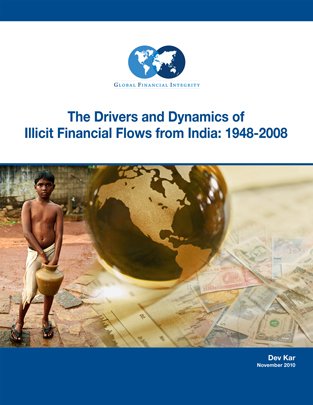“The Drivers and Dynamics of Illicit Financial Flows from India: 1948-2008,” released in November 2010 by Global Financial Integrity (GFI), estimates that tax evasion, crime, and corruption have removed gross illicit assets from India worth US$462 billion. The report also finds that the faster rates of economic growth since economic reform started in 1991 led to a deterioration of income distribution which led to more illicit flows from the country.
Moreover, the report finds that the poor state of governance is reflected in a growing underground economy which in turn has fueled more transfers of illicit capital from India. This analysis is cast in terms of a pre- and a post-reform period spanning a total of 61 years since independence.

Download Full Report
Primary Findings
From 1948 through 2008 India lost a total of US$213 billion in illicit financial flows (or illegal capital flight). These illicit financial flows were generally the product of: corruption, bribery and kickbacks, criminal activities, and efforts to shelter wealth from a country’s tax authorities. (51)
Adjusted Estimates: The present value of India’s total illicit financial flows (IFFs) is at least US$462 billion. This is based on the short-term U.S. Treasury bill rate as a proxy for the rate of return on assets. (51)
IFF Breakdowns:
Total capital flight represents approximately 16.6 percent of India’s GDP as of year-end 2008; (51)
Illicit financial flows out of India grew at a rate of 11.5 percent per year while in real terms they grew by 6.4 percent per year; ( 51)
India lost US$16 billion per year from 2002-2006. (1)
- IFF Drivers: High Net-Worth Individuals (HNWIs) and private companies were found to be the primary drivers of illicit flows out of India’s private sector. (ix). India’s underground economy is also a significant driver of illicit financial flows. (53)
- IFF Trends: From 1948 through 2008 the Indian private sector shifted away from deposits into developed country banks and towards increased deposits in offshore financial centers (OFCs). The share of OFC deposits increased from 36.4 percent in 1995 to 54.2 percent in 2009. (x).
Analysis
India’s underground economy is closely tied to illicit financial outflows. The total present value of India’s illicit assets held abroad (US$462 billion) accounts for approximately 72 percent of India’s underground economy. This means that almost three-quarters of the illicit assets comprising India’s underground economy—which has been estimated to account for 50 percent of India’s GDP (approximately US$640 billion at the end of 2008)—ends up outside of the country. (vii, 19)
The finding that only 27.8 percent of India’s illicit assets are held domestically support arguments that the desire to amass wealth illegally without attracting government attention is one of the primary motivations behind the cross-border transfer of illicit capital. (vii, 19)
In the post-reform period of 1991-2008, deregulation and trade liberalization accelerated the outflow of illicit money from the Indian economy. Opportunities for trade mispricing grew and expansion of the global shadow financial system—particularly island tax havens—accommodated the increased outflow of India’s illicit capital flight. (Introduction)
There is a statistical correlation between larger volumes of illicit flows and deteriorating income distribution. (35)
Recommendations
Tax evasion is a major component of the underground economy, which in turn is a primary driver of India’s illicit outflows. Expanding India’s tax base and improving tax collection has high potential to curtail illicit flows.
Illicit financial flows cannot be curtailed without the collaborative effort of both developing and developed countries. Economic reforms key to stemming the outflow of illicit money from India and the developing world in general include:
- curtail trade mispricing (a widely utilized tax avoidance technique of international businesses);
- require country-by-country reporting of sales, profits and taxes paid by multinational corporations;
- require confirmation of beneficial ownership in all banking and securities accounts;
- require automatic cross-border exchange of tax information on personal and business accounts; and
- harmonize predicate offenses under anti-money laundering laws across all countries that cooperate on the Financial Action Task Force.
Methodology
Dev Kar, the author of the report, utilized the World Bank Residual Model (CED) and a trade Mispricing Model based on IMF Direction of Trade statistics.
The World Bank Residual Model tracks illicit outflows by measuring differences in a country’s recorded source of funds relative to its use of funds. According to this method, illicit outflows exist when a country’s recorded source of funds exceeds its recorded use of funds.
The Trade Mispricing Model compares a country’s recorded imports to what the world says it exported to that country; similarly, the country’s recorded exports are compared against world imports from that country. Import values are adjusted for the cost of freight and insurance before they are compared to exports. GFI’s estimates of trade mispricing are based on the gross excluding reversals (GER) method which tracks illicit outflows as a result of export under-invoicing and import over-invoicing.
The author identified the drivers of illicit flows from India using a block-recursive dynamic simulation model which incorporated macroeconomic factors (government deficits, inflation, and inflationary expectations) structural factors (increasing trade openness, faster rates of economic growth and impact of these on income distribution), and overall governance as captured by a measure of the underground economy.
GFI recommends citing from the most recently released research. Look at the Reports page to find the most recent annual report.

